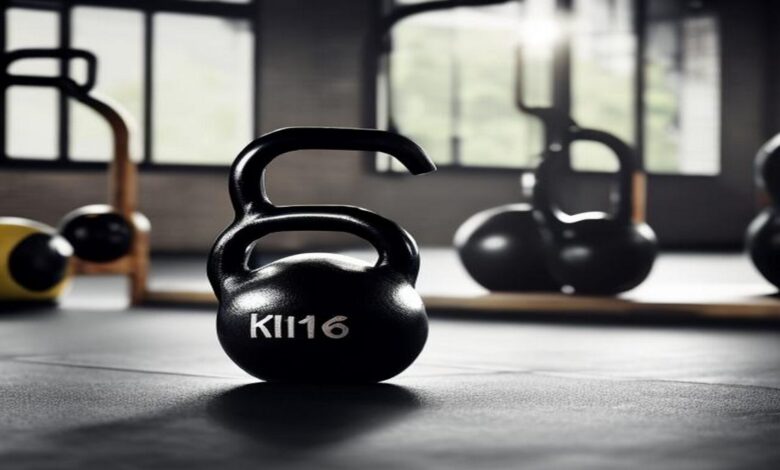10-Minute Kettlebell Workout: Quick & Effective Tips

When you think of efficient workouts, what’s the first thing that comes to your mind? For many, it’s the rising trend of 10-minute kettlebell workouts. As our lives become increasingly busy, fitness routines that pack a punch in minimal time are a lifesaver. Wouldn’t you agree?
1. Introduction
If you’ve been searching for a versatile workout tool, look no further. Kettlebells are revolutionizing how we perceive fitness, making those hefty gym memberships seem overrated. Their unique shape and varied weight options offer a plethora of kettlebell exercises suitable for both beginners and seasoned fitness enthusiasts.
- Why Kettlebells?
- Compact and space-saving
- Multi-functional, addressing various muscle groups
- Suitable for all fitness levels
1.1. The Rising Popularity of Kettlebell Workouts
But wait, how did kettlebells, once a tool relegated to the corner of the gym, become a global sensation? The digital age played a role, sure. Social media platforms were flooded with influencers showcasing their at-home kettlebell workout routines. But there’s more.
- Driving Factors:
- Adaptability: Suitable for both kettlebell workout for women and men.
- Versatility: Incorporate them in your cardio, strength training, or even kettlebell hiit workout.
- Economical: One-time investment, lifelong benefits.
1.2. Benefits of Quick Kettlebell Routines
We get it – time is a luxury. And that’s where the magic of the 10-minute kettlebell workout shines. But can such short sessions truly be effective? Let’s dive deep.
- Key Advantages:
- Comprehensive: Get a full body kettlebell workout in a fraction of the time.
- Efficient: Boost your metabolism and experience kettlebell workouts for fat loss.
- Convenient: Perfect for those always on-the-go or favoring kettlebell workout at home.
1.3. Overview of the Article Content
Stick around, and we’ll unravel the world of kettlebell workouts. From understanding the basics of kettlebell training to decoding the most effective moves like the kettlebell swing, we’ve got you covered. And if you’re a newbie, we’ll walk you through a kettlebell workout for beginners that’s both fun and effective. Intrigued? Let’s jump right in!
- What’s in Store?
- Core principles of kettlebell exercises.
- Tailored routines, such as those focusing on upper body kettlebell exercises.
- Answering burning questions like “Does a kettlebell workout count as cardio?” or “How many kettlebell swings in 10 minutes?”.
The kettlebell wave is sweeping across the fitness community. With its adaptability and versatility, it’s not hard to see why. Whether you’re looking to sculpt, tone, or burn, a 10-minute kettlebell workout is your answer. So, are you ready to swing into action?
2. Kettlebell Basics
Have you ever been introduced to the world of kettlebell exercises? It’s a transformative fitness journey that offers a unique blend of strength and cardio training, ideal for those looking to maximize their workouts. This section aims to walk you through the essentials, making sure you’re geared up for your next 10-minute kettlebell workout!
Kettlebells, with their distinct cannonball-like shape and sturdy handle, are no new entrants in the fitness world. Originating in Russia, they’ve gradually won the hearts of fitness enthusiasts globally, primarily because of their versatility.
2.1. What is a kettlebells exercise?
A kettlebell exercise is more than just lifting weight; it’s about engaging multiple muscles simultaneously. This fitness equipment, with its offset center of gravity, ensures that even basic lifts become a full-body challenge.
- Full body kettlebell workout: Engages various muscle groups, ensuring a comprehensive training session.
- Kettlebell hiit workout: Combines high-intensity intervals, offering both strength and cardio benefits.
- Single arm swings, bent over rows: Examples of exercises targeting specific muscles while still offering an overall body workout.
So, how does one ensure they’re making the most of these exercises? The answer lies in understanding the fundamental movement patterns.
2.2. Importance of the movement pattern
Movement patterns are at the heart of kettlebell training. These aren’t just any movements; they’re foundational techniques that form the base of many exercises.
- Kettlebell swing: This is the bedrock of kettlebell exercises, focusing on the hip-hinge movement pattern.
- Reverse lunge with kettlebell pass: A complex move teaching coordination, balance, and utilizing the lunge pattern.
- Kettlebell halo: Perfect for shoulder mobility and stability, incorporating the upper body rotation pattern.
Having a strong understanding of these movement patterns isn’t just about efficiency; it’s about ensuring safety and maximizing benefits. But the question remains: why opt for kettlebells over traditional weights?
2.3. Kettlebell vs traditional weights
At a glance, dumbbells and kettlebells might appear as tools achieving the same goal. However, there’s more than what meets the eye.
- Design and distribution: Unlike dumbbells, kettlebells have an off-set center of gravity, demanding more stabilization and control.
- Dynamic exercises: Moves like kettlebell swings or snatches are challenging to replicate with regular weights.
- Functionality: Kettlebell workouts often mimic real-world activities, making them more functional and versatile.
Ever tried doing a kettlebell swing with a dumbbell? It’s not only challenging but might also lead to inefficient form. While both tools have their merits, kettlebells offer a unique blend of challenges and benefits, particularly for quick workouts.
Now, imagine the possibilities with just a 10-minute kettlebell workout at home. Short, intense, and supremely effective – it’s about making every second count. Ready to give it a whirl?
3. Designing the Perfect 10-Minute Kettlebell Workout
Kettlebells, with their unique shape and versatility, have surged in popularity as a prime tool for quick and efficient workouts. The 10-minute kettlebell workout is all about optimizing each second for maximum effect. But how do you make those 10 minutes count?
- Precision: Every movement needs intention.
- Efficiency: Cut the fluff and focus on what works.
- Diversity: Engage various muscles for balanced results.
With the right blend of exercises, your 10 minutes can be as effective as an hour on the gym floor. But how exactly do you design this routine?
3.1. How to structure a kettlebell workout?
Understanding how to structure a kettlebell workout is the foundation of crafting your perfect routine. The golden rule? Always start with a warm-up. Warm-ups prepare your muscles, reducing injury risks.
- Start with joint rotations: shoulders, hips, and knees.
- Progress to light kettlebell swings to activate your core and posterior chain.
- Conclude with dynamic stretches: think high leg kicks or torso twists.
Next, transition into the main workout. Remember, variety is crucial. Switching between upper body, lower body, and core exercises prevents muscle fatigue, allowing you to maintain intensity throughout.
3.2. Kettlebell exercises for a full-body workout
For a truly effective 10-minute kettlebell workout, you want to target as many muscle groups as possible. The beauty of kettlebells? They’re perfect for compound movements. Let’s dive into some core exercises:
- Kettlebell swing: A classic that targets the glutes, hamstrings, core, and shoulders.
- Single arm reverse lunge: Fantastic for legs and demands core stability.
- Bent over row: Great for your upper back and biceps.
If you’re doing a kettlebell workout for women or specifically a kettlebell workout for beginners, you might adjust the weight or reps, but the basic movements remain the same. Aim for movements that allow a full range of motion and engage multiple joints. Remember, it’s not just about ticking off a list; it’s about feeling each motion and making it count.
3.3. Tailoring the workout: For beginners vs seasoned practitioners
The best workouts are those tailored to the individual. A kettlebell workout for beginners might focus on form, while seasoned kettlebell users might amp up intensity.
- Newbies:
- Prioritize mastering the movement pattern.
- Begin with lighter kettlebells.
- Take it slow, focusing on form rather than speed.
- Veterans:
- Incorporate advanced moves like the kettlebell halo or kettlebell hiit workout elements.
- Challenge yourself with heavier weights or increased reps.
- Mix in complex movements like combining a squat with a press.
Everyone starts somewhere, right? So whether it’s your first time or your hundredth, the goal is to keep improving, keep challenging yourself, and, most importantly, keep moving!
Remember, the 10-minute kettlebell workout is not about how long you’re working out but how effectively you utilize those minutes. By integrating variety, focusing on form, and pushing yourself within your limits, you’re not just ticking off a workout. You’re investing in your health, one kettlebell swing at a time.
4. Dive into the 10-Minute Routine
Ever felt the thrill of achieving a lot in a short span? A 10-minute kettlebell workout can evoke that. This routine doesn’t mean skimping on the intensity; it means maximizing every second.
- The essence? Efficient kettlebell exercises.
- The goal? Targeting every major muscle group.
- The bonus? Boosting your metabolism for post-workout fat burn.
4.1. Kettlebell swing and its variations
Ah, the classic kettlebell swing! At the heart of kettlebell routines, it’s a full-body movement that enhances strength and coordination.
- The movement pattern: Starting in a squat, you swing the kettlebell upward as you stand, then let it fall back down.
- Variations: The single arm swing and the kettlebell halo. Switching hands or circling the kettlebell around your head brings new challenges.
- Benefits? Improved strength, especially in the core and posterior chain.
Ever wondered, “how many kettlebell swings in 10 minutes?” Aim for consistency rather than sheer numbers, ensuring each swing is precise.
4.2. Integrating kettlebell hiit workout elements
Kettlebell hiit workout is a game-changer. High-Intensity Interval Training (HIIT) combined with kettlebells creates a synergy for fat burn.
- Bent over row for your upper body. The trick? Keep your back straight, pull the kettlebell towards your hip.
- Reverse lunge for the legs. Holding a kettlebell adds resistance, enhancing muscle activation.
- Remember the golden rule: Intensity. It’s not about how long, but how hard you push.
Does this replace cardio? Here’s food for thought: Does a kettlebell workout count as cardio? Absolutely, especially when integrating HIIT.
4.3. 10-minute kettlebell workout at home: Setting up the space
Thinking of an at-home kettlebell workout? The convenience is unmatched. But, ensuring a safe and conducive environment is pivotal.
- Space: Clear out a space around you. A radius where you can swing the kettlebell without knocking anything over.
- Equipment: A good quality kettlebell. For beginners, it’s essential to start light and progress.
- Ambiance: Perhaps some motivational tunes? Or the 10-minute kettlebell workout joe wicks swears by?
Ever thought, “Is 10 minutes of kettlebells enough?” At home, uninterrupted, it can be a powerhouse of a workout.
Every 10-minute kettlebell workout promises a blend of strength training and cardio. Perfect for those on-the-go days. And for the days you have a little more time? Perhaps explore the “Is a 15-minute kettlebell workout effective?” spoiler: It absolutely is!
Remember, consistency over perfection. Start light, focus on the technique, and watch yourself transform. Ready to swing into action?
5. Additional Tips and Tricks
Beginning a kettlebell workout journey can seem daunting. The weight’s unique shape and the variety of exercises can make anyone feel overwhelmed. But with a bit of guidance, it’s a journey worth taking.
- Dive deep into online resources, from tutorial videos to blog posts.
- Consistency is key; it’s better to do a 10-minute kettlebell workout daily than an hour once a week.
- Safety first! Always ensure you’re using the correct form to prevent injuries.
5.1. Kettlebell workout for beginners: Starting off right
If you’re a newbie to kettlebell exercises, congratulations on making a fantastic choice! Kettlebells offer an efficient, full-body workout, combining strength training and cardio. But how does one start?
- Focus on mastering basic movements like the kettlebell swing or kettlebell halo.
- Don’t rush; it’s crucial to understand the movement pattern before increasing weight or speed.
- Get guidance. Whether from a friend, online videos, or a personal trainer, feedback on form is invaluable.
5.2. Does a kettlebell workout count as cardio? – Debunking myths
One of the most common myths is that kettlebells are only for strength training. Is that true? Definitely not.
- Kettlebell hiit workout routines elevate your heart rate, giving you a cardio boost.
- Routines like the 10-minute kettlebell core workout combine strength and cardio for a balanced session.
- The rapid, explosive movements, especially in kettlebell swings, can indeed count as cardio. Ever tried doing those for a full 10 minutes?
5.3. Benefits of kettlebell workouts for fat loss
There’s a buzz about kettlebells being a secret weapon for fat loss. And guess what? There’s truth in it.
- The blend of strength and cardio means you’re burning calories during and after the workout, thanks to the afterburn effect.
- Full body kettlebell workout engages multiple muscles at once, leading to more significant calorie burn.
- Incorporating upper body kettlebell exercises and kettlebell workouts for fat loss in a single routine ensures a holistic approach to shedding those extra pounds.
Why not start with a 10-minute kettlebell workout at home? You’ll be surprised at the results. Remember, it’s all about incorporating the right kettlebell exercises with consistency and dedication.
Conclusion
Embarking on your kettlebell journey can be one of the best decisions for your fitness. From toning your body to enhancing cardiovascular health, it’s a versatile tool that promises results. Whether you’re a beginner or looking to debunk myths, the kettlebell world is vast and filled with potential. So, why wait? Grab your kettlebell, and let’s swing into action!
6. Common Questions and Answers
We all have queries when diving into a new 10-minute kettlebell workout regime. Kettlebell training, though effective, often brings up a set of common questions. Let’s address them one by one.
Why consider kettlebell exercises? Kettlebells, with their unique shape and design, target multiple muscle groups, offering a full-body workout. They are particularly effective for those short on time, looking for quick, intense routines.
6.1. How many kettlebell swings in 10 minutes?
So, you’re curious about the number of kettlebell swings you can achieve in 10 minutes? It’s an excellent metric to measure your stamina and endurance.
- Beginners: Aim for 150 to 200 swings. It’s essential to focus on form over speed.
- Intermediate to Advanced: You can push for 300 to 500 swings. Ensure your movement pattern is consistent to avoid strain.
But remember, the exact number can vary based on your kettlebell training experience, the weight you’re using, and your overall physical condition. Always listen to your body!
6.2. Is a 15-minute kettlebell workout effective?
Absolutely! But as with any workout, it’s about quality, not just duration. A 15-minute kettlebell workout can be incredibly efficient if done right.
- Intensity: Ensure you’re pushing yourself in those 15 minutes. The aim is to get your heart rate up.
- Variety: Incorporate a mix of kettlebell exercises, like the kettlebell swing, bent over row, and reverse lunge.
A quick tip? Consider integrating a kettlebell HIIT workout into those 15 minutes. You’ll feel the burn and see results faster!
6.3. Calories burned in 10-minute kettlebell workout
One common metric many aim to understand is the caloric burn of a 10-minute kettlebell workout. Well, the results might surprise you!
- Intensity Matters: A high-intensity session can burn anywhere from 100 to 250 calories.
- Factors at Play: Your weight, metabolic rate, and the weight of the kettlebell used play a role.
For those looking for weight loss, remember that kettlebell workouts for fat loss are a real thing. The afterburn effect post workout keeps your metabolism elevated, leading to more calories burned throughout the day.
In conclusion, whether you’re diving into kettlebell exercises as a beginner or someone looking to spice up their workout routine, kettlebells offer flexibility, intensity, and efficiency. Always remember to prioritize form and consistency. After all, isn’t it amazing what you can achieve in just 10 minutes? So, why not give it a swing?
7. Conclusion
In the realm of fitness, kettlebell exercises have surged as an efficient method to attain full body workouts within a short span. The beauty of a 10-minute kettlebell workout lies in its versatility, targeting both strength training and cardio, providing a holistic approach to fitness.
Moreover, kettlebells foster functional movement, replicating real-life activities, thereby enhancing one’s daily mobility and reducing the risk of injuries. For those always on the go, integrating this workout regime can be transformative.
- Calories burned in 10-minute kettlebell workout are relatively high.
- It caters to a full body kettlebell workout, ensuring comprehensive muscle engagement.
- Perfect for those seeking kettlebell workouts for fat loss due to its high-intensity nature.
7.1. Recapping the effectiveness of a 10-minute routine
The effectiveness of a 10-minute kettlebell workout isn’t just a fad; it’s backed by science. Intense, short bursts of kettlebell movements can elevate the heart rate swiftly, leading to improved cardiovascular health.
Additionally, the blend of kettlebell swing, reverse lunge, and upper body kettlebell exercises ensures that no muscle group is left untouched.
- Emphasizes on movement pattern to enhance functional fitness.
- Great as an at-home kettlebell workout due to minimal equipment needs.
- Ideal for both beginners and advanced fitness enthusiasts.
7.2. Encouraging consistent practice
Consistency is key in any fitness routine. With kettlebell training, the learning curve is steep, but the rewards are plenty. By maintaining regular practice, one can witness rapid improvements in strength, balance, and endurance.
Moreover, for those wondering, “Does a kettlebell workout count as cardio?”, the answer is a resounding yes. A brief session can rival the effects of a prolonged traditional cardio session.
- Kettlebell workout for beginners often paves the way for advanced movements.
- A consistent routine aids in achieving the kettlebell halo or the single arm swings with ease.
- Commitment leads to mastering even kettlebell hiit workouts, furthering one’s fitness journey.
7.3. Final words on advancing in kettlebell training
Kettlebell training is not just a passing trend. Its roots are deep-seated, drawing from traditional strength training techniques. As one progresses, it’s crucial to keep challenging oneself, be it through increased weights or advanced movements like the bent over row.
Remember, every kettlebell workout routine should resonate with your personal fitness goals. Whether it’s the 10-minute kettlebell core workout or any tailored regimen, it’s about pushing boundaries and attaining holistic health.
- Regular practice leads to mastering complex movements.
- One can transition from kettlebell workout for beginners to advanced levels with diligence.
- Always prioritize form over speed to prevent injuries.
So, are you ready to embark on this invigorating fitness journey with kettlebells? Dive in, stay consistent, and witness transformative results.





